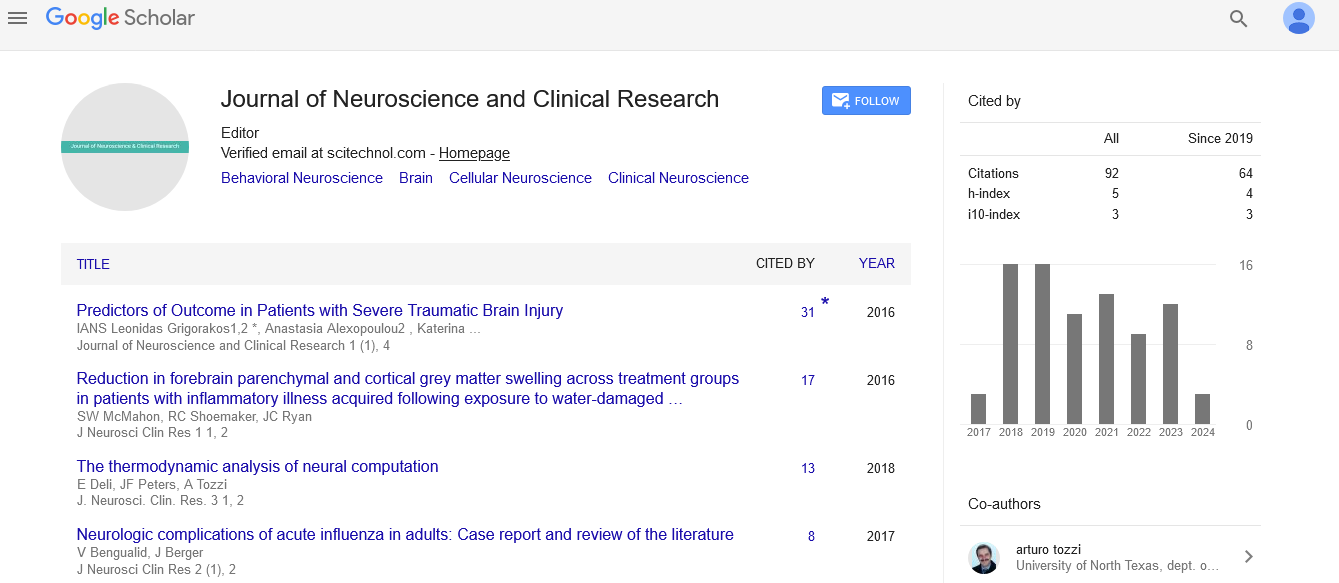Substance dependence alters serum lipid levels in addicted male patients
Xiaoni Zhang, Lihuan Lan and Ying Peng
Sun Yat-Sen Memorial Hospital-Sun Yat-Sen University, China
: J Neurosci Clin Res
Abstract
Objectives: Studies have shown that opiate and heroin dependence causes alterations in serum lipids. In this study, we investigated the relationship between different types of substance dependence and serum lipid levels.
Methods: Serum lipid levels were measured in 97 patients with different types of substance dependence (heroin, methamphetamine, ketamine and codeine phosphate dependence), and in 99 healthy subjects. The clinical characteristics of substance-dependent patients were also investigated.
Results: Serum Total Cholesterol (TC; 3.74±1.02 mmol/L, P=0.017) and high-density lipoprotein cholesterol (HDL-C; 1.12±0.19, P=0.007) levels were lower, and triglyceride levels (TG; 1.73±0.89 mmol/L, P=0.008) were higher in the heroin dependence group compared to the control group. Serum TG (1.74±1.11 mmol/L, P=0.000), HDL-C (1.44±0.30 mmol/L, P=0.011), apolipoprotein A-1 (ApoA-1; 1.55±0.28 g/L, P=0.000), and apolipoprotein B (ApoB; 1.55±0.28 g/L, P=0.000) levels were higher in the methamphetamine dependence group, while serum TG (2.49±1.56 mmol/L, P=0.000) and ApoB (0.93±0.25 g/L, P=0.000) levels were higher in the ketamine dependence group compared to the control group. Additionally, the codeine dependence group exhibited higher serum TG (1.94±1.34 mmol/L, P=0.000) and ApoB (0.82±0.28 g/L, P=0.003) levels. We also found that patients with psychotic symptoms had significantly higher TG levels in the heroin, methamphetamine and ketamine dependence groups and lower TC and HDL-C levels in the heroin dependence group.
Conclusion: Our data suggested that different types of substance dependence caused varying degrees of change in serum lipid levels and that hypertriglyceridemia was consistent with psychotic symptoms in substance abuse patients.
References
1. Kouros D (2010) Opium and heroin alter biochemical parameters of human's serum. The American Journal of Drug and Alcohol Abuse; 36(3): 135-9.
2. Wai MS (2012) Long-term ketamine and ketamine plus alcohol treatments produced damages in liver and kidney. Human & Experimental Toxicology; 31(9): 877-86.
3. Lehto SM (2010) Low serum HDL-cholesterol levels are associated with long symptom duration in patients with major depressive disorder. Psychiatry and Clinical Neurosciences; 64(3): 279-83.
4. Shin EJ (2012) Role of oxidative stress in methamphetamine-induced dopaminergic toxicity mediated by protein kinase Cdelta. Behavioural Brain Research; 232(1): 98-113.
5. McKetin R (2013) Dose-related psychotic symptoms in chronic methamphetamine users: evidence from a prospective longitudinal study. JAMA Psychiatry; 70(3): 319-24.
Biography
Xiaoni Zhang has her expertise in clinical and mechanism studies of substance dependence. She has completed her MD and MS at Sun Yat-Sen University, China. She is currently a Resident at Department of Neurology, Sun Yat-Sen Memorial Hospital, Sun Yat-Sen University. Her research field is focused on substance dependence and morphine-induced immunosuppressive effects.
E-mail: xiaoni3440@163.com
 Spanish
Spanish  Chinese
Chinese  Russian
Russian  German
German  French
French  Japanese
Japanese  Portuguese
Portuguese  Hindi
Hindi 